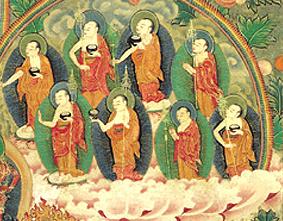Arhat: Difference between revisions
Jump to navigation
Jump to search
m (→Internal Links) |
No edit summary |
||
| Line 1: | Line 1: | ||
[[Image:Shravakas.JPG|frame|[[Shravaka]] disciples from the [[Longchen Nyingtik]] [[field of merit|Field of Merit]]]] | [[Image:Shravakas.JPG|frame|[[Shravaka]] disciples from the [[Longchen Nyingtik]] [[field of merit|Field of Merit]]]] | ||
'''Arhat''' (Skt.; Tib. [[དགྲ་བཅོམ་པ་]], ''drachompa''; [[Wyl.]] ''dgra bcom pa'') — the ultimate result of the [[shravaka yana]] and [[pratyekabuddha yana]]. One who has completely overcome the enemy of the [[disturbing emotions]] and is therefore worthy of praise. | '''Arhat''' (Skt.; Tib. [[དགྲ་བཅོམ་པ་]], ''drachompa''; [[Wyl.]] ''dgra bcom pa'') — name given to the ultimate result of the [[shravaka yana]] and [[pratyekabuddha yana]], which differ in terms of realisation and qualities. Arhat is also used as an epithet of the [[Buddha]]. One who has completely overcome the enemy of the [[disturbing emotions]] and is therefore worthy of praise. | ||
==Subdivisions== | ==Subdivisions== | ||
Revision as of 16:16, 20 January 2012

Arhat (Skt.; Tib. དགྲ་བཅོམ་པ་, drachompa; Wyl. dgra bcom pa) — name given to the ultimate result of the shravaka yana and pratyekabuddha yana, which differ in terms of realisation and qualities. Arhat is also used as an epithet of the Buddha. One who has completely overcome the enemy of the disturbing emotions and is therefore worthy of praise.
Subdivisions
There are two kinds of arhat: those with remainder and those without remainder.
How an Arhat teaches
Arhats teach by means of the three pure factors (Tib. དག་པ་གསུམ་, Wyl. dag pa gsum)[1]
Alternative Translations
- foe destroyer (Light of Berotsana)
References
- ↑
 Patrul Rinpoche, Preliminary Points To be Explained when Teaching the Buddha's Word or the Treatises, translated by Adam Pearcey.
Patrul Rinpoche, Preliminary Points To be Explained when Teaching the Buddha's Word or the Treatises, translated by Adam Pearcey.